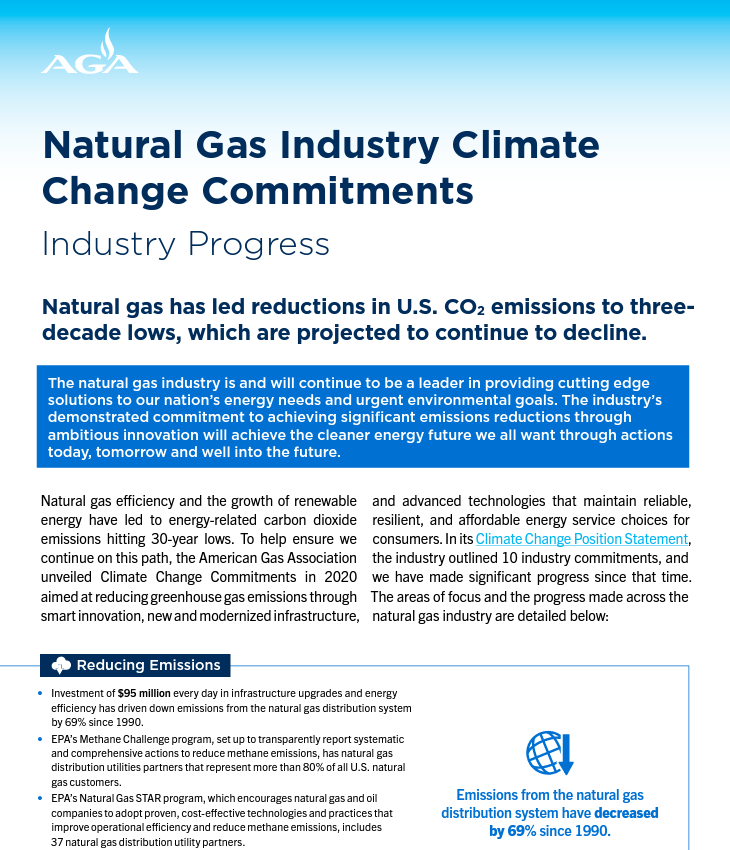Natural Gas Industry Climate Change Commitments
Natural gas has led reductions in U.S. CO2 emissions to three- decade lows, which are projected to continue to decline.

The natural gas industry is and will continue to be a leader in providing cutting edge solutions to our nation’s energy needs and urgent environmental goals. The industry’s demonstrated commitment to achieving significant emissions reductions through ambitious innovation will achieve the cleaner energy future we all want through actions today, tomorrow and well into the future.
Natural gas efficiency and the growth of renewable energy have led to energy-related carbon dioxide emissions hitting 30-year lows. To help ensure we continue on this path, the American Gas Association unveiled Climate Change Commitments in 2020 aimed at reducing greenhouse gas emissions through smart innovation, new and modernized infrastructure, and advanced technologies that maintain reliable, resilient, and affordable energy service choices for consumers.
In its Climate Change Position Statement, the industry outlined 10 industry commitments, and we have made significant progress since that time. The areas of focus and the progress made across the natural gas industry are detailed below:
Reducing Emissions
- Investment of $95 million every day in infrastructure upgrades and energy efficiency has driven down emissions from the natural gas distribution system by 69% since 1990.
- EPA’s Methane Challenge program, set up to transparently report systematic and comprehensive actions to reduce methane emissions, has natural gas distribution utilities partners that represent more than 80% of all U.S. natural gas customers.
- EPA’s Natural Gas STAR program, which encourages natural gas and oil companies to adopt proven, cost-effective technologies and practices that improve operational efficiency and reduce methane emissions, includes 37 natural gas distribution utility partners.
- Natural gas is responsible for 62% of cumulative carbon dioxide emissions savings due to changes in the electricity generation fuel mix.
Emissions from the natural gas distribution system have decreased by 69% since 1990.
Energy Efficiency
- The industry invested $4.3 million every day, or $1.5 billion, on advancing energy efficiency in 2019.
- Utilities invest more than 50% of their energy efficiency portfolios into customer incentives such as rebates, loans and other financial incentives to drive market penetration.
- Energy efficiency investments from 2013 to 2019 saved more than 13.5 million metric tons of CO2 emissions, which equates to taking more than 2.9 million cars off the road.
- During the past 20 years, carbon dioxide emissions from the residential, commercial, and industrial natural gas sector are virtually unchanged as emissions from individual consumers have declined.
- This decline is a direct result of energy efficiency improvements, including tighter building envelopes, more efficient appliances and equipment, behavioral changes in energy consumption, and the effectiveness of natural gas utility efficiency programs.
Continued improvements in natural gas efficiency have reduced residential emissions per customer by 47% since 1971.
Modernizing Natural Gas Pipelines
- America’s natural gas utilities invest $91 million every day ($29.5 Billion annually) on enhancing the safety of natural gas distribution and transmission systems.
- Forty-one states and DC have programs or policies to accelerate pipeline replacement, driving down emissions and continuing to enhance system safety.
- Over the past three years, the industry has added 62,172 additional miles of distribution pipe.These ongoing efforts help ensure the safety of customers and communities and at the same time provide environmental benefits in driving down emissions.
Investment in Next Generation Technologies
- Renewable natural gas production capacity expanded to nearly 60 trillion Btu’s of natural gas, which would fill the volume of 663,250 Olympic size swimming pools.
- The natural gas industry launched a $125 million research initiative to drive innovation and deploy next generation technologies including renewable natural gas and hydrogen.
- There are nearly 500 RNG facilities in operation or planned in North America today: 200 in operation today in the U.S., 155 under construction, and 103 more planned across the United States and Canada.
- More than 25 AGA members are actively exploring and investing in hydrogen as part of their emission reduction and decarbonization strategies.
Encourage Sustainable and Responsible Development and Transport of Natural Gas
- AGA and the Edison Electric Institute developed and launched the Natural Gas Sustainability Initiative, a comprehensive Methane Intensity reporting protocol to help incentivize and recognize methane emissions from companies in all sectors of the natural gas supply chain from production through distribution.
- Certified/Responsible Natural Gas offerings have expanded rapidly in 2021, including producers that have calculated the methane intensity of their operations and had their superior performance certified by independent auditors. Certified gas is a methane fuel that has environmental advantages that differentiate it from the regular geologic natural gas.
Focus on Customers and Communities
- The industry adds one new customer every minute and 21,000 new business customers each year.
- The industry added nearly 900,000 new residential customers in the U.S. between 2019-2020, the largest increase since 2006.
- More than 4.1 million jobs are connected to the natural gas industry, including more than three million connected to the delivery of natural gas to homes and businesses.
- The affordability of natural gas saves homeowners significantly, more than $1,000 each year, allowing families to have more money for what they need.
The natural gas delivery system is 91% efficient from production to customer, meaning less energy is wasted in the delivery of natural gas.
